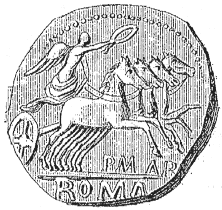Numismatics
Today, let's see what's written on coins. The University of Houston's College of Engineering presents this series about the machines that make our civilization run, and the people whose ingenuity created them.
Coin collectors call their work numismatics, or the science of coins. That may sound pretentious, but think for a minute about what coins are. They're the most durable written record -- a record that reflects the myths and legends of people. They tell you what we honor and what we find beautiful. American coins show us buffalo and Indians, wheat, Miss Liberty, bald eagles, and former presidents. They affirm our trust in God -- variable though that conviction may be.
Coinage is an odd technology. Coins are two things at once -- an historical record and a claim to goods and services. Since the metal they're made of has value, that claim survives long after they're issued. Bronze coins minted by the first-century Roman Emperor Domitian were still being used in Spain as late as the 17th century. Philip IV finally called them in to restamp them.
I have in my hand a late 2nd-century-BC Roman denarius. Jupiter's picture is on the front; a Roman war chariot, called a quadriga, is on the back. The rim is chipped all the way around. That's from the old way of making coins. A silver blank was stamped. Then fragments were nipped out of the unstamped rim until the coin had the right weight. That finicky little silver-saving process gave us the expression "penny-pinching." It also showed that the coin was solid -- not just silver-plated.
A century later, the new gods -- the Imperial Caesars -- had replaced the old household dieties on the front of the denarius. The republic was now an empire. The old war chariot survived for a while. Rome kept its interest in war.
Here's a handful of contemporary Cayman Island coins. What do Caymanians think about? For one thing, they voluntarily claim membership in the British Commonwealth. So we see Queen Elizabeth on all their coins. But on the other side are boats, birds, shrimp, and the Caymanian national symbol -- the turtle. Anyone looking at these coins a thousand years from now will be able to see the islands and their natural beauty through Caymanian eyes.
Money, after all, represents the works of our hands -- our technology. Our interest in money has a component that's far more honorable than greed. Money represents what we do. And what we do is what we are. A curious biblical remark tells us that our heart will be where our treasure is. It sounds cynical at first, but it makes more sense when we see money as a kind of condensed representation of ourselves. In the end, it's not surprising that we reveal our hearts in this most peculiar art form. We say who we are, and what we value, when we coin money.
I'm John Lienhard, at the University of Houston, where we're interested in the way inventive minds work.
(Theme music)
For more on coins and money, see Episode 40.
This episode has been greatly revised as Episode 1689.

(Clipart)
Typical picture of a quadriga on the back of a Roman coin

(clipart)